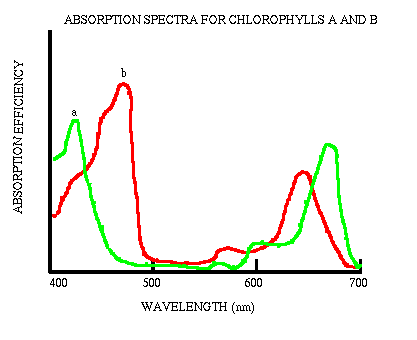PhotosynthesisPhotosynthesis is the process by which organisms that contain the pigment chlorophyll convert light energy into chemical energy which can be stored in the molecular bonds of organic molecules (e.g., sugars). Photosynthesis powers almost all trophic chains and food webs on the Earth.The net process of photosynthesis is described by the following equation: 6CO2 + 6H2O + Light Energy = C6H12O6 + 6O2 This equation simply means that carbon
dioxide from the air and water combine in the presence of sunlight to form
sugars; oxygen is released as a by-product of this reaction.
Light Reactions and the Calvin CycleThe process of photosynthesis is broken up into two main groups of reactions: the "light reactions" which require light energy to operate, and the "Calvin cycle" which specifically takes carbon dioxide and turns it into organic molecules. The electromagnetic energy of sunlight is converted to chemical energy in the chlorophyll-containing cells of photosynthetic organisms. In eukaryotic cells these reactions occur in the organelle known as the chloroplast. In the chloroplast, chlorophyll is the pigment that absorbs the sunlight. Chlorophyll is typically packed into stacks of membranes (called grana); it is in the grana where some of the sunlight is absorbed. Sunlight is converted to chemical energy in the form of ATP (adenosine triphosphate), which is the main energy-storing molecule in living organisms. ATP is then transported throughout the chloroplast and used to provide the chemical energy necessary to power other metabolic reactions. For example, some of the ATP is used to power the metabolic reactions in the conversion of CO2 into sugars and other compounds.Photosynthesis in a ChloroplastSome terms and definitions:
During the process of photosynthesis, light penetrates the cell and passes into the chloroplast. The light energy is intercepted by chlorophyll molecules on the granal stacks. Some of the light energy is converted to chemical energy. During this process, a phosphate is added to a molecule to cause the formation of ATP. The third phosphate chemical bond contains the new chemical energy. The ATP then provides energy to some of the other photosynthetic reactions that are causing the conversion of CO2 into sugars. While the above reactions are proceeding CO2 is diffusing into the chloroplast. In the presence of the enzyme Rubisco, one molecule of CO2 is combined with one molecule of RuBP, and the first product of this reaction is two molecules of PGA. The PGA then participates in a cycle of reactions that result in the production of the sugars and in the regeneration of RuBP. The RuBP is then available to accept another molecule of CO2 and to make more PGA.
Which wavelengths of the solar
spectrum drive photosynthesis?
How do we know the O2 is derived from H2O during photosynthesis?The oxygen product of photosynthesis could originate from either the CO2 or the H2O starting compounds. To determine which of these original compounds contributed to the O2 end product, an isotopic tracer experiment was performed using 18O:How do we know what the first products of photosynthesis are?Another isotopic tracer experiment:14C is a radioactive isotope of carbon. 14CO2 is exposed for a brief period to a green plant that is conducting a photosynthesis in the presence of sunlight. Immediately after exposure to 14CO2, the plant's photosynthetic tissue is killed by immersing it in boiling alcohol, and all of the biochemical reactions cease. The chemical compounds in the dead tissue are all extracted and studied to determine which of them possesses the 14C. Following the briefest exposure to 14CO2, the only chemical compound that possessed 14C was PGA (phosphoglyceric acid, a three carbon molecule). Following longer periods of exposure, much of the 14C was found in a variety of compounds including glucose. By varying the length of the exposure period it was possible to identify the sequence of the reactions leading from PGA to glucose. This research was conducted by Prof.
Melvin Calvin and his colleagues at the Univ. of California, Berkeley.
Calvin received the Nobel Prize for this work.
MetabolismWe have seen how plants convert sunlight into sugars. Now we need to understand how cells can use the products of photosynthesis to obtain energy. There are several possible metabolic pathways by which cells can obtain the energy stored in chemical bonds:Glycolysis:Glycolysis can occur in either the absence or the presence of oxygen. During glycolysis, glucose is broken down to pyruvic acid, yielding 2 ATP of energy. Glycolysis occurs in the cytoplasm of cells, not in organelles, and occurs in all kinds of living organisms. Prokaryote cells use glycolysis and the first living cells most likely used glycolysis.Fermentation:During fermentation, the pyruvic acid produced during glycolysis is converted to either ethanol or lactic acid. This continued use of pyruvic acid during fermentation permits glycolysis to continue with its associated production of ATP.Cellular Respiration:Respiration is the general process by which organisms oxidize organic molecules (e.g., sugars) and derive energy (ATP) from the molecular bonds that are broken.Glucose (a sugar):C 6H12O6Respiration is the opposite of photosynthesis, and is described by the equation: C6H12O6+6O2 ----------> 6CO2+6H2O+36ATP Simply stated, this equation means that oxygen combines with sugars to break molecular bonds, releasing the energy (in the form of ATP) contained in those bonds. In addition to the energy released, the products of the reaction are carbon dioxide and water. In eukaryotic cells, cellular respiration begins with the products of glycolysis being transported into the mitochondria. A series of metabolic pathways (the Krebs cycle and others) in the mitochondria result in the further breaking of chemical bonds and the liberation of ATP. CO2 and H2O are end products of these reactions. The theoretical maximum yield of cellular respiration is 36 ATP per molecule of glucose metabolized. ** Note that photosynthesis is a
reduction-oxidation reaction, just like respiration (see the primer on redox
reactions from the lecture on Microbes). In respiration energy is released from
sugars when electrons associated with hydrogen are transported to oxygen (the
electron acceptor), and water is formed as a byproduct. The mitochondria
use the energy released in this oxidation in order to synthesize ATP. In
photosynthesis, the electron flow is reversed, the water is split (not formed),
and the electrons are transferred from the water to CO2 and in the
process the energy is used to reduce the CO2 into sugar. In
respiration the energy yield is 686 kcal per mole of glucose oxidized to CO2,
while photosynthesis requires 686 kcal of energy to boost the electrons from the
water to their high-energy perches in the reduced sugar -- light provides this
energy.
Suggested Readings |

